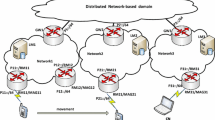Abstract
A drawback of the conventional Internet routing architecture is that its route computation and packet forwarding mechanisms are poorly integrated with congestion control mechanisms. Any datagram offered to the network is accepted; routers forward packets on a best-effort basis and react to congestion only after the network resources have already been wasted. A number of proposals improve on this to support multimedia applications; a promising example is the Integrated Services Packet Network (ISPN) architecture. However, these proposals are oriented to networks with fairly static topologies and rely on the same conventional Internet routing protocols to operate. This paper presents a routing architecture for mobile integrated services networks in which network nodes (routers) can move constantly while providing end-to-end performance guarantees. In the proposed connectionless routing architecture, packets are individually routed towards their destinations on a hop by hop basis. A packet intended for a given destination is allowed to enter the network if and only if there is at least one path of routers with enough resources to ensure its delivery within a finite time. Once a packet is accepted into the network, it is delivered to its destination, unless resource failures prevent it. Each router reserves resources for each active destination, rather than for each source–destination session, and forwards a received packet along one of multiple loop-free paths towards the destination. The resources and available paths for each destination are updated to adapt to congestion and topology changes. This mechanism could be extended to aggregate dissimilar flows as well.
Similar content being viewed by others
References
D. Bertsekas, Dynamic behavior of shortest path routing algorithms for communication networks, IEEE Trans. Automat. Control AC-27 (1982) 60–74.
D. Bertsekas and R. Gallager, Data Networks, 2nd edn. (Prentice-Hall, 1992).
R. Braden, L. Zhang, S. Berson, S. Herzog and S. Jamin, Resource reservation protocol (RSVP) – version 1 functional specification, RFC 2205 (September 1997).
D.D. Clark, S. Shenker and L. Zhang, Supporting real-time applications in an integrated services packet network: architecture and mechanisms, in: Proc. ACM SIGCOMM'92(August 1992).
R.L. Cruz, A calculus for network delay, part II: network analysis, IEEE Trans. Information Theory 37 (1991) 132–141.
A. Demers, S. Keshav and S. Shenker, Analysis and simulation of a fair queueing algorithm, ACM SIGCOMM (1989) 1–12.
D. Ferrari, A. Banerjea and H. Zhang, Network support for multimedia–a discussion of the tenet approach, Computer Networks and ISDN Syst. 26(10) (1994) 1167–1180.
S. Floyd and V. Jacobson, The synchronization of periodic routing messages, IEEE/ACM Trans. Networking 2(2) (April 1994) 122–136.
J.J. Garcia-Luna-Aceves, Loop-free routing using diffusing computations, IEEE/ACM Trans. Networking (February 1993) 130–141.
J.J. Garcia-Luna-Aceves and S. Murthy, A path finding algorithm for loop-free routing, IEEE/ACM Trans. Networking (February 1997).
J.J. Garcia-Luna-Aceves and S. Murthy, A loop-free path-finding algorithm: specification, verification and complexity, in: INFOCOM, Boston (April 1995).
H.T. Kung, T. Blackwell and A. Chapman, Credit-based flow control for ATM networks: credit update protocol, adaptive credit allocation, and statistical multiplexing, in: ACM SIGCOMM, Vol. 24, London, UK (Aug/Sept 1994) pp. 101–114.
C. Ozveren, R. Simcoe and G. Varghese, Reliable and efficient hop-by-hop flow control, in: SIGCOMM, London (Aug/Sept 1994) pp. 89–110.
A.K. Parekh and R.G. Gallager, A generalized processor sharing approach to flow control in integrated services networks: the singlenode case, IEEE/ACMTrans. Networking 1(3) (June 1993) 344–357.
A.K. Parekh and R.G. Gallager, A generalized processor sharing approach to flow control in integrated services networks: the multiple node case, IEEE/ACM Trans. Networking 2(2) (April 1994) 137–150.
S. Murthy and J.J. Garcia-Luna-Aceves, An efficient routing protocol for wireless networks, ACM Mobile Networks and Applications Journal 1(2) (1996).
Z. Wang and J. Crowcroft, QoS routing for supporting resource reservation, http://boom.cs.ucl.ac.uk/staff/zwang/pub.htm (1996).
Author information
Authors and Affiliations
Rights and permissions
About this article
Cite this article
Murthy, S., Garcia-Luna-Aceves, J. A routing architecture for mobile integrated services networks. Mobile Networks and Applications 3, 391–407 (1998). https://doi.org/10.1023/A:1019105622361
Issue Date:
DOI: https://doi.org/10.1023/A:1019105622361




